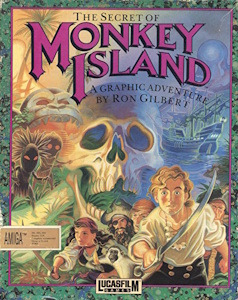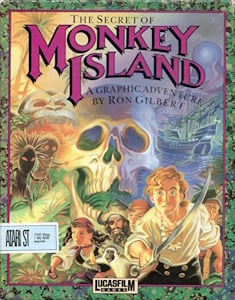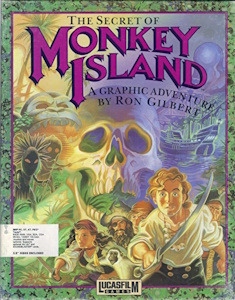The Secret of Monkey Island (1990-)
The Secret of Monkey Island was developed by Lucasfilm Games, later known as LucasArts, and released in 1990. Published by Lucasfilm Games as well, it quickly became one of the most iconic adventure games of its era. Set in a humorous and pirate-themed world, the game follows the story of Guybrush Threepwood, a young man aspiring to become a legendary pirate. The game stood out for its clever writing, engaging puzzles, and charming art style, blending classic point-and-click mechanics with a strong narrative focus. Its inspiration came from pirate lore, swashbuckling films, and a desire to create a game that balanced comedy and adventure.
Originally developed for the Amiga and MS-DOS platforms, The Secret of Monkey Island was later ported to various systems, including the Macintosh, FM Towns, and even the Sega CD. These versions helped the game reach a broad audience and cement its place as a foundational title in the graphic adventure genre. The gameplay features involved exploring locations, collecting items, engaging in witty dialogues, and solving puzzles that often required creative thinking rather than brute force. The interface was intuitive, relying on a verb-based command system that encouraged experimentation and discovery.
The game’s soundtrack, composed by Michael Land, played a significant role in setting the tone and atmosphere. The memorable music blended Caribbean-inspired themes with a lighthearted, adventurous spirit, enhancing the immersive experience without overpowering the gameplay. The sound effects, from the clashing of swords to the ambient sounds of a bustling pirate town, further enriched the world. This audio design was a key element in establishing the game’s unique charm and contributed to its lasting appeal.
The Secret of Monkey Island did not have a prequel, but it spawned several sequels that expanded on the story and characters introduced in the original game. The most notable sequel, Monkey Island 2: LeChuck’s Revenge, released in 1991, continued Guybrush’s adventures with even more intricate puzzles and deeper narrative layers. The series later expanded with titles such as The Curse of Monkey Island and Escape from Monkey Island, each building upon the foundations laid by the original while introducing new gameplay innovations and visual upgrades.
Promotion of The Secret of Monkey Island capitalized on its unique blend of humor, story, and gameplay. Lucasfilm Games used gaming magazines, trade shows, and word of mouth to highlight the game’s witty script, vibrant graphics, and innovative approach to adventure gaming. It was marketed as a game that could appeal to both casual players and seasoned adventure game fans, emphasizing its accessible controls and rich storytelling. This approach helped generate significant interest and contributed to strong sales upon release.
Upon its release, The Secret of Monkey Island was met with critical acclaim and quickly became a beloved classic. Reviewers praised its sharp writing, memorable characters, and well-designed puzzles, which struck a perfect balance between challenge and accessibility. The game’s humor and style set it apart from other adventure titles, and it has since been recognized as one of the greatest video games of all time. Its influence can be seen in numerous adventure games that followed, and it continues to be celebrated by fans and critics alike for its timeless appeal and innovative design.
Images from MobyGames
Buy The Secret of Monkey Island
Click one of the Ebay or Amazon buttons below to check the latest prices and purchase The Secret of Monkey Island for that particular platform.



Related Searches
The Secret of Monkey Island is available to purchase and download from a range of vendors. Always shop....
The Secret of Monkey Island may be available to download as abandonware from one of the many sites...
There are various sites out there that can offer cheat codes for games. Search now to find all available...
There are many sites out there that have collated and documented historic reviews of this game. Search now...
We don't host or link to rom sites for this game. However, there are many sites out there that may be...
The initial release date for The Secret of Monkey Island is stated as October 1990. Other ports of the....
The Secret of Monkey Island is available to purchase and download from the link(s) shown further up this....
There are multiple sites around the internet that offer visual guides to this game. Search now to find the....








